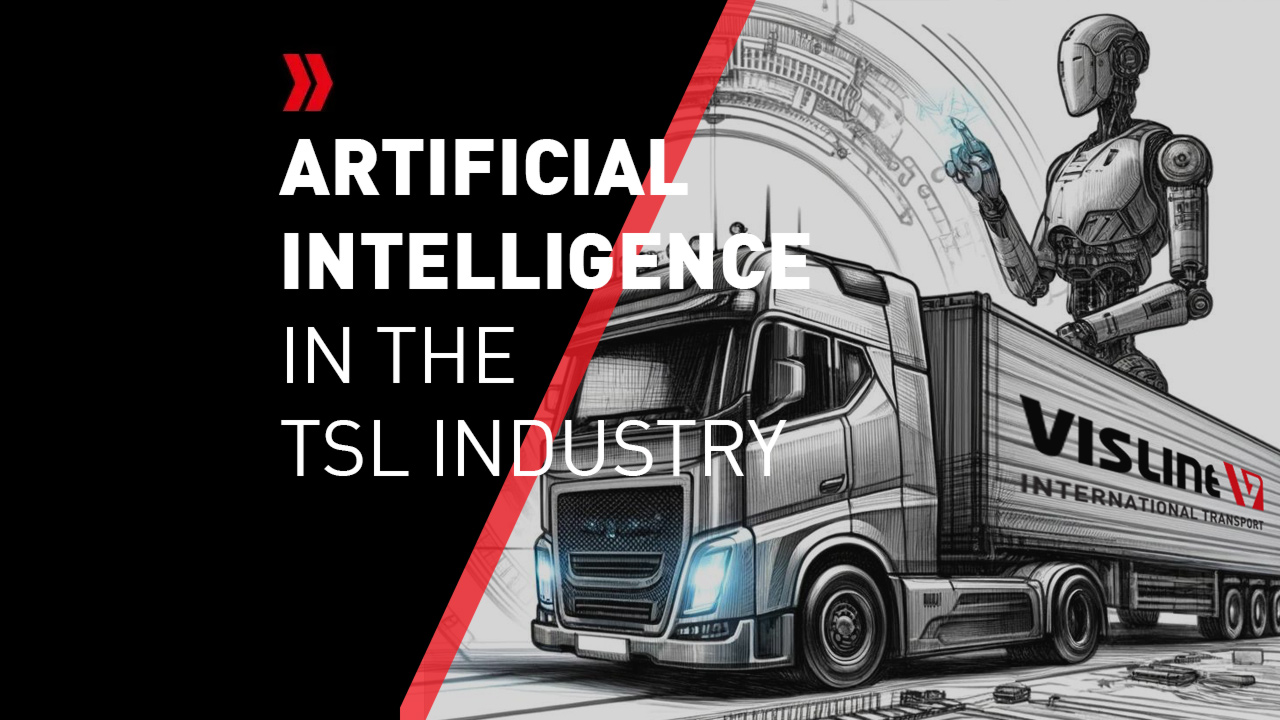Artificial Intelligence in the TSL Industry
Aleksandra Hanusik
Updated 30.10.2024 | Published 06.06.2024
6 min reading time

According to Eurostat data, 30% of large European companies use artificial intelligence technology. Among them are corporations in the TSL industry.
The most spectacular examples of implementation can be found by following major brands such as DHL Freight, GEFCO, and Kuehne + Nagel. The effects of these implementations were often: freight rate prediction, route optimization, fuel consumption reduction, and cargo organization.
You can read this article in 3 minutes and learn how to start implementing AI in your business.
Not Just Market Giants
When we scale down AI implementations to smaller businesses that do not have the same resources and budgets as market giants, we can still talk about equally attractive optimization potential. However, the problems they face, such as lack of skills, experience, ideas, and awareness of potential, remain barriers that limit the introduction of modern solutions. Therefore, following the motto Driving the Future, we at Visline took a step further, deciding to take on the challenge posed by the digital transformation in the transport industry.
How to Start Your Journey with AI?
One incentive to introduce artificial intelligence in a company can be a significant return on investment in AI. By realizing how much automation and optimization can impact our business, you can quickly begin the first implementations. Even if we save a few hours of human labor per month, in the long run, this value can allow a specialist to find time to develop their skills. Transport and forwarding, where processes are repetitive, regular, and measurable, are ideal for this. Here are some areas where implementations are worth considering:
Customer Service
- Communication optimization
- Language translation
- Pricing automation
- Insights recognition
Quotation Process
- Price predictions
- Precise route planning
- Fuel consumption reduction
- Selection of loads for combined transport orders
Administrative Support
- Document flow automation
- Document recognition
- Business partner verification
- Notification systems
For companies starting work with AI projects, the preparatory steps are crucial. AI is not just Chat GPT, but many other ready-made specialized tools waiting for implementation. However, before we get to them, it is important to take care of several processes that will not only facilitate but also enable implementation. Here is a list of conditions that need to be met:
1) Compliance with the Law – Even the best idea must take into account the regulations regarding the use of AI. The AI ACT, adopted in the first half of 2024, clearly defines which activities are allowed, which are high-risk, and which are strictly prohibited. A lot of attention is also paid to copyright law (e.g., when feeding AI with external data) and the proper protection of sensitive data.
2) Skills – This is essential. To a certain extent, we can rely on our own resources, but without specialists in AI project management, we risk incorrectly defining the needs that we present to an external implementation company. At Visline, we created a separate team dealing with artificial intelligence because we know that the IT department’s skills alone are not enough to define the project’s framework and coordinate its implementation. Implementation requires specialization. A good expert will be able to determine the return on investment and the project’s chances of success in terms of time, finances, and feasibility, as well as safety issues.
3) Own Resources – AI will not meet our expectations without the right data. There are two basic models for implementing artificial intelligence. In very simple terms:
The first is based on publicly available data supplemented with selected proprietary data. This way, the robot’s responses are tailored to the specifics of our business. This solution is called “RAG,” or Retrieval Augmented Generation.
The second approach involves adapting a pre-trained model to a specific data set, selected to perform a particular task, e.g., to recognize whether an image shows a passenger car or a truck, by showing a series of pictures of passenger cars and larger-tonnage vehicles and marking the correct ones. This method is called fine-tuning.
Regardless of which solution we choose, without properly organized data, the models will not be able to provide valuable answers. Here lies the biggest obstacle – where to get the data and how to properly prepare it? If we do not have properly organized information, the first step in implementing AI will be to acquire and properly arrange it. Companies using many different systems, where the data is difficult to integrate into a cohesive whole, will be in a much more challenging situation.
Simple Solutions for Here and Now
Even if implementing dedicated models is not possible due to a lack of organized data, other solutions can be considered. General tools like Chat GPT or Copilot offer many possibilities that can optimize at least part of the processes. Here are some examples:
- Text Translation – Chat GPT, as a language model, is excellent for this. In the current version, the robot perfectly translates nuances and content written in specialized language. Many online translators already use this technology.
- Summary Generation – The chat can also help us prepare meeting notes, summarize large documents, or extract interesting information from a chart board.
- Content Creation and Text Correction – We can use artificial intelligence to create content for the website, social media, or document preparation. Of course, the final touch should be given by a human, but AI-generated content can be a good starting point. Chat GPT is also useful for correcting texts written by us, which can be significant in business correspondence.
Digital Visline
We are aware that thanks to modern solutions, we can significantly improve the quality of the services provided, from forwarding to the accounting department, as well as the company’s functioning, from safety to innovation. At Visline, the high responsiveness of the customer service department translates into customer satisfaction, as does the speed of document delivery or managing unforeseen situations. Artificial intelligence also affects work comfort, turning tedious tasks into fully automated processes.
Finally, it is worth mentioning the cultural and social aspect. AI solutions are new to many, so implementation should be transparent for employees and preceded by consultations. Just as personal computers once replaced typewriters, AI is now another tool designed to support humans, not replace them. Therefore, fears of mass layoffs due to robot implementation are often created by people who do not understand this technology and its application in business. AI will not replace humans, but a person who can use it can replace someone who does not know it.



